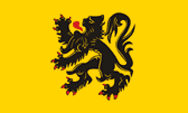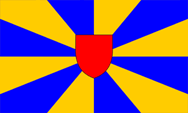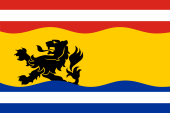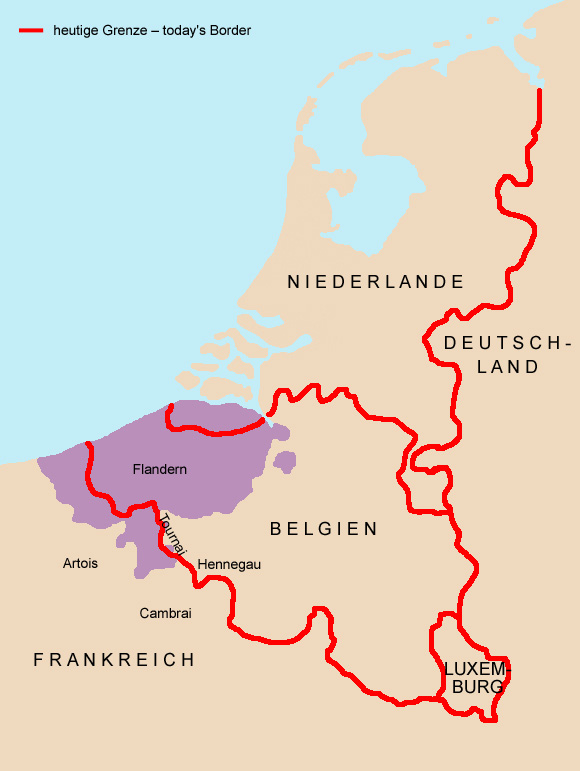The historical Flanders is today separated in four regions, respectively it exists within other borders:
•
State-Flanders, since 1648 part of the Netherlands, the mainland of the Dutch Province of Zeeland
•
Belgian Flanders, today separated in the Belgian provinces of
East Flanders,
West Flanders and parts of
Hainaut
•
Flanders, since 1980 one of the two components of federal Belgium (Flanders in the north,
Wallonia in the south)
•
French Flanders,
since 1659 to France, today the Department Nord
• Flag
• Coat of Arms
• Meaning/Origin of the Flag
• Map
• Numbers and Facts
• History
• Origin of the Country's Name

Flag of Flanders,
Source, by:
Flags of the World






Flag of Ancient Flanders,
Source, by:
Flags of the World






Flag of State-Flanders,
Source, by:
Wikipedia (NL)





Coat of arms of Ancient Flanders,
Source:
Wikipedia (D)

Coat of arms of New Flanders
Source:
Wikipedia (D)

Flanders knows today two flags, both of which go back to historical coat of arms of the country:
1) The coat of arms of Ancient Flanders how it since 15 Century was known: yellow and blue gestural changes, with a red heart tag. The Belgian province of West Flanders still used a flag with the image.
2) The coat of arms of New Flanders. Probably during the reign of the Habsburgs became the County of Flanders gave a different symbol. It showed a black, red armored lion on gold, a heraldry that is still very common and widely known, not least as a symbol of Flanders as a federal unit of the present-day Belgium.
The in 1960 created region "Nord - Pas - de - Calais", uses an unofficial flag modeled on the coat of arms of New Flanders. The same flag is used in Belgian Flanders.
In Dutch State-Flanders (Zealand-Flanders, Zeeuws-Vlaanderen) an own flag is in use since the year 2009. It is the common symbol of the three municipalities of Terneuzen, Sluis and Hulst and shows nine stripes in red-white-red-yellow-blue-white-blue in a ratio of 1:1:1:6:1:1:1. In the yellow stripe, moved towards the mast, appears the black lion of Flanders, which also appears in the coat of arms of Hulst. The traditional red reinforcement (tongue and claws) of the lion was deliberately omitted in order to make the lion look "younger, more robust and more dynamic". The upper red stripes come from the flag of Sluis, while the lower blue stripes come from the flag of Terneuzen.
Source: Volker Preuß, Wikipedia (NL)


Source:
Volker Preuß

Area: at the time of its greatest expansion, the County of Flanders covers an area of about 7.700 square miles
Capital: Gent and Bruges
Language: Flemish (Dutch dialect)
other Languages: French
Source:
Atlas zur Geschichte,
Wikipedia (D)

58–51 B.C. · Roman conquest
3rd century A.D. · settlement by Franks and Frisians
481–843 · to the Frankish Empire
8th century · formation of the County of Flanders
880 · Treaty of Verdun and Ribbemont, at the division of the Frankish Empire comes West Flanders (now known as Crown Flanders) to the West Frankish Kingdom (France) and East Flanders (now known as Imperial Flanders) to the East Franconian Empire (German Empire)
1007 · the Margrave of West Flanders gets East Flanders as a fiefdom by the German Emperor
1050 · Flanders expands by wars to the east from the Scheldt River to Dender River, in the south acquisition of Cambrai and Tournai
1045 · cede of Valenciennes to the County of Hainaut
1170 · acquisition of Vermandois
1180 · cede of Artois to France
1191 · vanish of the Counts of Flanders, Flanders comes as heir to the House of Dampierre of Hainaut
1205 · the County of Flanders becomes transferred to a Dampierre at the division of an estate
1345–1384 · war between France and Flanders
1385 · Burgundy acquires Flanders by marriage of the heir to the throne
1555 · the House of Habsburg inherits the Burgundian territories
1648 · State Flanders comes to the Netherlands (until today part of the Netherlands)
1659 · France conqueres the western parts of Flanders (until today part of France)
1792–1794 · French troops conquer Flanders
1797 · Flanders is annexed by France
1815 · Congress of Vienna, Flanders becomes a part of the Kingdom of the United Netherlands
1830 · creation of the Belgian State (Belgium), Belgian-Flanders is initially divided in the two départements Escault and Lys, later the two provinces of West Flanders and East Flanders
Source:
Atlas zur Geschichte,
Wikipedia (D)

The name "Flanders" goes back the old word "Fladmari", what means "shallow marshes" and it stated at the beginning only the area around the city of Bruges.
Source:
Handbuch der geographischen Namen


![]()















